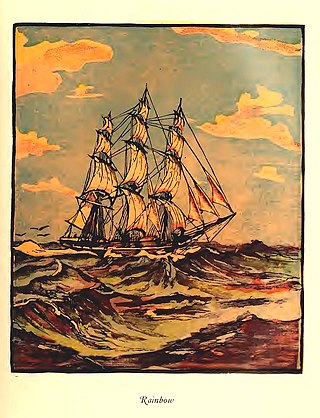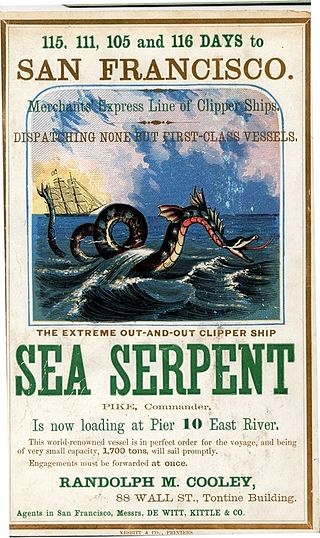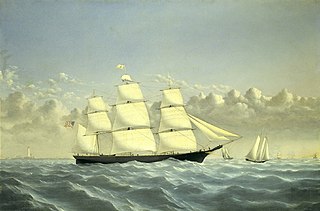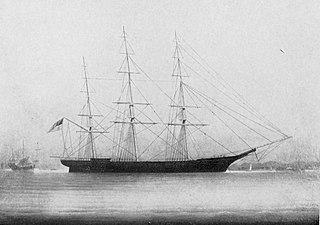Related Research Articles

A clipper was a type of mid-19th-century merchant sailing vessel, designed for speed. Clippers were generally narrow for their length, small by later 19th-century standards, could carry limited bulk freight, and had a large total sail area. "Clipper" does not refer to a specific sailplan; clippers may be schooners, brigs, brigantines, etc., as well as full-rigged ships. Clippers were mostly constructed in British and American shipyards, although France, Brazil, the Netherlands, and other nations also produced some. Clippers sailed all over the world, primarily on the trade routes between the United Kingdom and China, in transatlantic trade, and on the New York-to-San Francisco route around Cape Horn during the California Gold Rush. Dutch clippers were built beginning in the 1850s for the tea trade and passenger service to Java.

James Hudson Taylor was a British Baptist Christian missionary to China and founder of the China Inland Mission. Taylor spent 54 years in China. The society that he began was responsible for bringing over 800 missionaries to the country who started 125 schools and directly resulted in 20,000 Christian conversions, as well as the establishment of more than 300 stations of work with more than 499 local helpers in all 18 provinces.

Marco Polo was a three-masted wooden clipper ship, launched in 1851 at Saint John, New Brunswick. She was named after Venetian traveler Marco Polo. The ship carried emigrants and passengers to Australia and was the first vessel to make the round trip from Liverpool in under six months. Later in her career, the ship was used as a cargo ship before running aground off Cavendish, Prince Edward Island, in 1883.

Lammermuir was an extreme clipper ship built in 1864 by Pile, Spence and Company of West Hartlepool for John "Jock" "White Hat" Willis & Son, London. She was the second ship to bear the name. The first Lammermuir had been the favorite ship of John Willis, and was wrecked in the Gaspar Strait in 1863.

The Lammermuir Party was a British group of Protestant missionaries who travelled to China in 1866 aboard the tea clipper Lammermuir, accompanied by James Hudson Taylor, the founder of the China Inland Mission. Mission historians have indicated that this event was a turning point in the history of missionary work in China in the 19th century. This was the largest party of Protestant missionaries to date to arrive at one time on Chinese shores. It was also noteworthy that none of the members of the mission were ordained ministers, and only two had any previous overseas experience. In addition to this, there were among them nine unmarried women traveling to a place where single European women were rare for many reasons.

Sea Witch was an American clipper ship designed by naval architect John W. Griffiths for the China trading firm of Howland & Aspinwall. She was launched at Smith & Dimon in Manhattan on December 8, 1846.
Captain Joseph Warren Holmes was an American sea captain noted for sailing around Cape Horn 84 times and Cape of Good Hope 14 times without a shipwreck or loss of a crewman. He had a 63-year career at sea, including 55 commanding clipper ships and others. He was the captain of more voyages around Cape Horn than anyone else.

Robert H. Waterman, known as Bully Waterman or Bully Bob Waterman, was an American merchant sea captain. He set three sailing speed records; his time of 74 days from Hong Kong to New York City has never been bettered in a sail-powered vessel. He was reputed as a martinet, and was once convicted of assault against a crewman in a controversial California criminal case.

Elizabeth Chamberlain Gibson was the wife of the Methodist missionary Otis Gibson.

Rainbow, launched in New York in 1845 to sail in the China trade for the firm Howland & Aspinwall, was a clipper, a type of sailing vessel designed to sacrifice cargo capacity for speed.

Surprise was a California clipper built in East Boston in 1850. It initially rounded Cape Horn to California, but the vessel's owners, A. A. Low & Brother, soon found that the vessel performed well in Far Eastern waters. From that point onward the vessel spent much of her working life in the China trade, although the vessel also made three trips from the East Coast of the United States to California.

Sea Serpent was an 1850 extreme clipper that sailed in the San Francisco trade, the China trade, and the transatlantic lumber trade. She was one of the longest lived clippers, with a service life of 36 years and 5 months.

The Memnon was the first clipper ship to arrive in San Francisco after the Gold Rush, and the only clipper to arrive in San Francisco before 1850. Built in 1848, she made record passages to San Francisco and to China, and sailed in the first clipper race around Cape Horn.

Race Horse was an 1850 clipper barque. She set a record of 109 days from New York to San Francisco during the first Clipper Race around the Horn.
Antelope was a medium clipper built in 1851 in Medford, near Boston, Massachusetts. She sailed in the San Francisco, China, and Far East trades, and was known for her fine finish work and for her crew's escape from pirates. She is often called Antelope of Boston to distinguish her from the extreme clipper Antelope of New York launched in 1852.

Golden West was an 1852 extreme clipper built by Paul Curtis. The ship had a very active career in the California trade, the guano trade, the coolie trade, the Far East, and Australia. She made a record passage between Japan and San Francisco in 1856.

Comet was an 1851 California clipper built by William H. Webb which sailed in the Australia trade and the tea trade. This extreme clipper was very fast. She had record passages on two different routes: New York City to San Francisco, and Liverpool to Hong Kong, and beat the famous clipper Flying Dutchman in an 1853 race around the Horn to San Francisco.

Mary Ann Brown Patten or Patton was the first female commander of an American merchant vessel. She was the wife of Joshua Patten, captain of the merchant clipper ship Neptune’s Car. The ship was bound around Cape Horn from New York towards San Francisco when Joshua Patten collapsed from fatigue in 1856. His wife took command for 56 days, faced down a mutiny, and successfully managed to navigate the clipper ship into San Francisco. At the time of docking, she was 19 years old and eight months pregnant with her first child.

Gravina was an 818-register ton clipper ship built in Hoboken, New Jersey, in 1853. A rare example of a clipper built in the United States for foreign owners, Gravina was originally homeported in Spain, though commanded by an American.

The Patrick Henry (packet) was a three-masted, square-rigged, merchant-class, sailing packet ship that transported mail, newspapers, merchandise and thousands of people from 1839 to 1864, during the Golden Age of Sail, primarily between Liverpool and New York City, as well as produce, grains and clothing to aid in humanitarian efforts during an Gorta Mór.
References
- ↑ "University of Connecticut Digital Mosaic". Captain Joseph Warren Holmes of Mystic. University of CT. 2009 [1908]. Archived from the original on July 20, 2011. Retrieved May 9, 2010.
- ↑ "The Sea Witch". eraoftheclipperships.com. 2009. Retrieved September 25, 2009.
- ↑ D. Blethen Adams Levy (2009). "Captain Robert "Bully" Waterman". The Maritime Heritage Project. Retrieved September 25, 2009.
- ↑ Warner, Ezra J (1964). Generals in Blue: Lives of the Union Commanders . Baton Rouge: Louisiana State University Press. p. 5. ISBN 0-8071-0822-7.
- ↑ <BT122/30 at TNA>
- ↑ <BT122/29 at the TNA>
- ↑ <BT122/29 at TNA>
- ↑ "Captain Michael A. Healy, USRCS". Archived from the original on 2017-05-02. Retrieved 2010-09-30.
- ↑ Nitch, Steven (November–December 2006). "VISIONS OF HONOR: A Special Look at Gettysburg Medal of Honor recipient Brigadier General Edmund Rice". FindArticles. Retrieved 2007-05-30.[ permanent dead link ]
- ↑ Butow, By R.J.C. (Fall 1999). "A Notable Passage to China, Myth and Memory in FDR's Family History". Prologue Magazine. Washington, DC: The U.S. National Archives and Records Administration. 31 (3). Retrieved June 11, 2010.
- ↑ A Volume of Memoirs and Genealogy of Representative Citizens of the City of Seattle and County of King, Washington. New York and Chicago: Lewis Publishing Co. 1903. p. 167. Archived from the original on 2010-09-29.
- ↑ Gibson, Eliza C. (1916), A Trip to China Archived 2011-07-23 at the Wayback Machine , California Christian Advocate